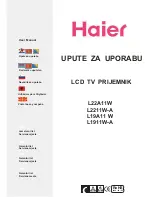
●
Display provided when Self-Diagnostic Function started
The display is as described below depending on the situation when the power to this unit is turned off.
1. When the power is turned off by usual operation:
“NO PROTECT” is displayed. Then “A1-1. NORMAL” is displayed in a few seconds.
N O P R O T E C T
A 1 - 1
N O R M A L
Main menu display
Opening message
After a few seconds
Notes:
•
Applying the power to this unit without correcting the abnormality can be dangerous and cause
additional circuit damage. To avoid this, if “I PROTECT” protection function works 1 time, the power
will not turn on even when the “ ” (Power) key is pressed. In order to turn on the power again, start up
the self-diagnostic function.
•
The output transistors in each amplifier channel should be checked for damage before applying power
to this unit.
•
Amplifier current should be monitored by measuring DC voltage across the emitter resistors for each
channel.
Cause:
An excessive current flowed through the power amplifier.
Supplementary information:
As current of the power amplifier is detected, the abnormal channel can be
identified by checking the current detect transistor.
Turning on the power without correcting the abnormality will cause the protection function to work immediately
and the power supply will instantly be shut off.
2. When the protection function worked to turn off the power:
The information of protection function which worked at that time is displayed. Then “A1-1. NORMAL” is displayed in a
few seconds.
Note: At that time if you restart the self-diagnostic function after turning off the power once, “NO PROTECT” will be
displayed. That is because that situation is equal to “1. When the power is turned off by usual operation:”.
However history of the protection function is stored in memory as backup data. For details, refer to “P2.
PROTECTION HISTORY” menu.
2-1. When there is a history of protection function due to excess current.
I P R O T E C T
19
R-N500
R-N50
0
Summary of Contents for R-N500
Page 3: ...FRONT PANEL REAR PANELS U C models R S models 3 R N500 R N500...
Page 4: ...K model A model B G models 4 R N500 R N500...
Page 5: ...L model 5 R N500 R N500...
Page 99: ...99 R N500 R N500 MEMO...
Page 100: ...R N500...
















































